Onimusha 2: Samurai's Destiny is a crisp remaster of a charming relic
Somehow, Oda Nobunaga returned
I'm a lifelong Resi fan but relatively late-coming Capcom devotee, so I find Onimusha 2: Samurai's Destiny's amalgam of more famed series hallmarks fun to think about - sitting as it does at the intersection of Devil May Cry's orb-sucking fighting game combat and Resident Evil's deliberate spatial awareness, fixed camera exploration and puzzles.
But I've also got some second-hand nostalgia for this 2002 action game. I didn't play it myself, although I did spectate snippets at a friend's house. I remember him having fun, although he may have mostly enjoyed boasting about how sword-tough he was in the face of the game's difficulty.
I have to call out his treachery up top, though. It's not actually that hard. Maybe this remaster helps with that. In brief, it's basically an extremely crisp port with some exfoliated textures and a few menu extras you can read about on its Steam page. Perhaps thanks to this crispy framerate, I even managed a few of the series' trademark Issen Counters in the few hours I spent playing, roughly up to the bit where you blithely hop on a mecha-horse and ride out of hell, which you basically take in your stride by this point because of everything leading up to it.
Issen Counters are like parries, but you use the attack button instead of blocking. What a wild, sorcerous artefact. It might actually be a superior system to something like Sekiro's in some ways. Parrying with the block button usually means a sloppy but safe deflect even if you whiff it. Here, you have to commit and succeed, or face the consequences. There's little as humiliating as being brazen enough to respond to scissors with scissors and getting out-snipped by a gangly lizard.
(My strongest memory of the friend's bedroom in which I watched Onimusha is the time I picked up his harmonica, blew a few notes, went to put it back, then realised a thriving, writhing colony of translucent buglets had marked the borders of their territory along the length of the middle octave. They did not taste especially fantastic. I was going to do a whole bit about how the bong we made from a Lucozade bottle and tried to recreate to less potent effect after the original crumbled to pieces was a metaphor for remake culture's doomed grasping at intangible era-specific phantoms but it didn't have much to it beyond that observation.)
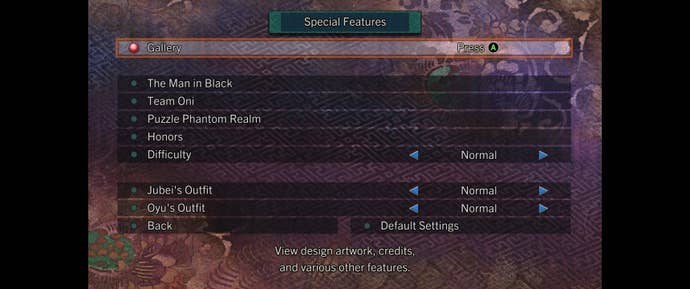
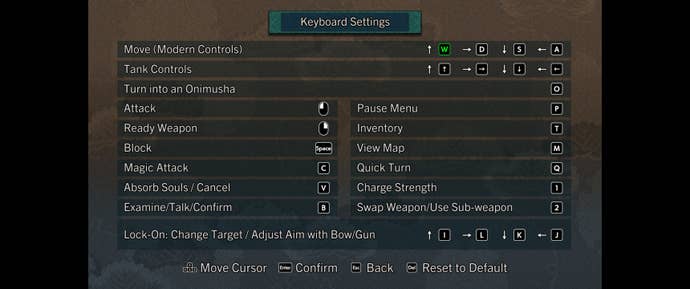
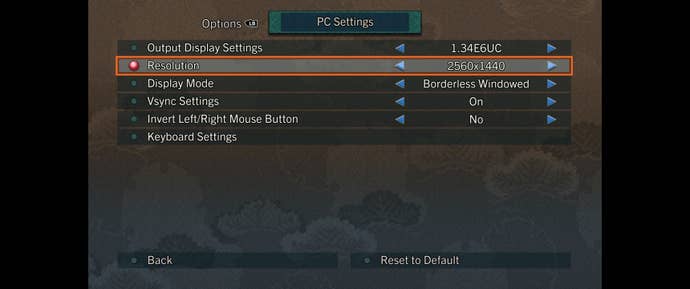
Pah, bad bugs. Much tastier are my memories of watching the deliberate character action of Onimusha 2, although I can't imagine its stilted, enthusiastically theatrical tone stood out then in quite the same way as it does now. This is prime Campcom. Less a Jill sandwich, more a Jill catering explosion of triangularly cut sandwichettes flung at you constantly with all the flair and abandon of a carnival knife trickster, each stuffed dummy thick with dialogue that decided the decade's B-movies were getting a bit too full of themselves.
The first boss you fight spouts boastful Saturday morning cartoon banter. Various camera angles conspire to get you crushed by falling rocks. A ways in to the fight, your teppo wielding buddy shows up with a "did you miss me?". The boss's final line, before sinking into the underworld from whence it learned to tutorialise the block breaking effects of jump attacks, is "I'll be back!".
But let's back up, because there is a story here. Somehow, Oda Nobunaga has returned. He's brought demons. Several of those demons are lifted straight from Berserk but what isn't. Your character, Jubei, goes through the heroically necessary ritual of suddenly not having a home village that isn't filled with dead people any longer, and you travel to a gold mining town named Imasho which acts as Onimusha 2's hub area.
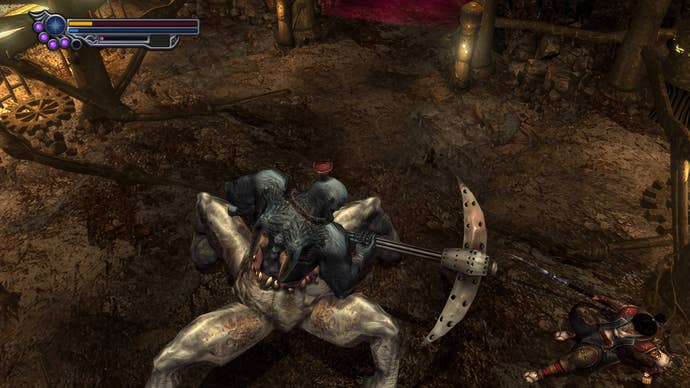
If my somewhat clumsy placement of this game between Resident Evil and DMC earlier suggested that its lacking its own distinct identity, Imasho is where its specific personality and structure starts to become most apparent. So far, I've found Ominusha 2 to be as much about the people you meet and lavish with gifts as it is about the demons you hit with various unlockable elemental weapons.
So take, for example, Ekei, of ample spear and ample-er gut. He enjoys either booze or things he can snack on while drinking, like pickled plums. There's a scene later where he plunges himself into a series of dangerous fights hoping to meet a distraught villager's missing daughter (the word 'daughter' excites him), with the punchline being that the daughter turns out to be a baby. I will pass no judgement on this humour, merely present it for you chew on like the 23 year old chestnut it is. I don't yet know if there's chance for Ekei to betray you later, but I looked up enough about the game to learn that this sort of thing can happen: either endearing or alienating various characters with gifts can alter how the story plays out later on.
And it's this bendable story structure, combined with its Spencer Mansion-ish (proto Souls-ish) hub design (reinforcing my belief that Dark Souls is spiritually sibling-ed with Resident Evil) that makes Onimusha 2 a worthwhile visit even if you don't have the nostalgia for it. Indeed, early combat variety comes less from the action itself, more from increasingly "lol, fuck you" tight environments that evoke the Spencer Mansion's zombie traffic-jammed upper floors. It all makes for a nourishing design tourism package holiday, if not a rip-roaring videogame entertainathon.
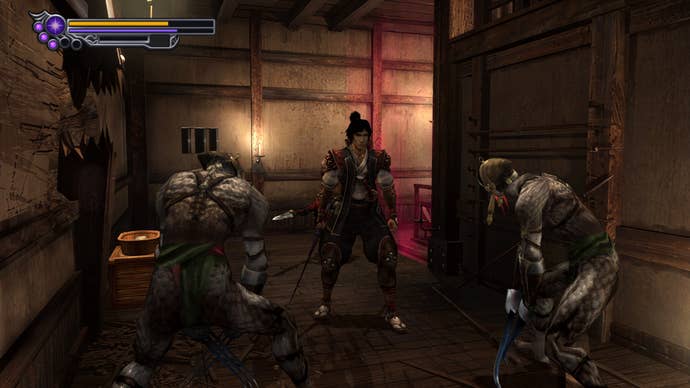
This package can't and obviously shouldn't erase some of its notable frustrations. The real game is often working out which way the edge of a pre-rendered scene will take you. Neither does it quality-of-lifelessly smooth out some of its more intoxicating peculiarities. Onimusha 2 has locks that, even if you possess the key for, you will need to go into your inventory and use that key in the general vicinity of the door, unguided by a prompt. You may consider this an inconvenience. For me, it lends a game a specific texture I do not currently have all the words to pin down. Perhaps the extra moment of consideration for the contents of my inventory simply provokes more investment. Maybe it just reminds me of Alone In The Dark. Either way, I like it.
I could not convince my friend who loved Onimusha to play Resident Evil. He didn't like tank controls, despite enjoying this series's fixed camera angles. I still don't know if he played Resi, and I've now played Onimusha, so I suppose he won. This here current game-product doesn't feel especially transformative, but it is a convenient bit of preservation of a game that, after even a few hours, I feel is definitely worth preserving.


